Sam Schweber’s book, In the Shadow of the Bomb: Oppenheimer, Bethe, and the Moral Responsibility of the Scientist (Princeton University Press, 2000), is a classic dual-biography of two physicists close to the dark atomic arts. I read Sam’s book very early on in my bomb-history career, and have also had the pleasure of spending some time around Sam when we shared an office for a year while I taught at Harvard.
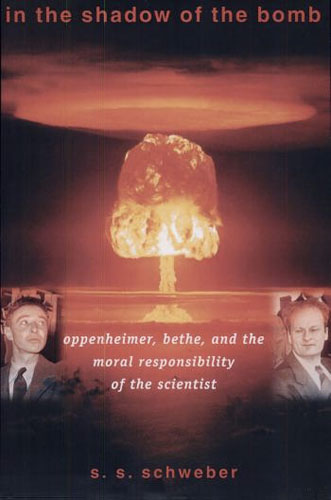
Castle ROMEO: Providing cover photographs for nuclear books since at least the 1980s.
Sam’s basic argument, to put it bluntly, is that J. Robert Oppenheimer was terribly inconsistent when it came to acting like an ethical human being, and his attempt to fly as high as possible led to his being burnt. Hans Bethe, on the other hand, did have some moments of considerable ethical wavering (his stance on the H-bomb being the most well-known), but generally speaking stood up for the right side of things and was far more consistent about his ethics.
I think it’s a fascinating book; for me, it helped draw attention to the aspects of Oppenheimer’s actions and character that get lost in the standard “martyr to McCarthyism” narrative. Oppenheimer was kind of a jerk — famously so. And he didn’t really take any kind of principled stand against the military-industrial complex: he was entirely complicit with it and always looking for a way to cooperate. Even his stance against building the H-bomb was 1. conditioned by the fact that he thought it would detract from an amassing a huge tactical weapons stockpile, and 2. dissipated the moment he saw the H-bomb as being technically feasible. This isn’t to say he was the worst of the bunch, but his reputation as principled opposition of the bomb is misattributed.
Bethe, on the other hand, managed to not only be more principled about his opposition to the H-bomb (except when he decided to work on it, but, as Sam emphasizes, this was originally because he hoped to show it was impossible), he also parlayed his security clearance into a life’s work of being an insider critic of US nuclear policies. He was also, by all accounts, not a jerk.
(Interesting factoid I will someday return to: I have a FOIA’d copy of Bethe’s FBI file. It is 500 pages of love from other physicists, plus occasional, accidental security breaches on Bethe’s part. A remarkable document in its lack of innuendo or scuttlebutt.)
Sam compared Oppenheimer and Bethe in terms of their ethics and behaviors. Since this is a blog, and it is Friday, I want to compare them by a different, perhaps more frivolous metric: their hairstyles in the 1930s. Because both young Oppenheimer and young Bethe rocked some considerable hair back in the days before the bomb.
All of the below images come from the amazing Emilio Segrè Visual Archives at the American Institute of Physics — my employer. These are very low-resolution versions of the images in question; the high-res files are impressively detailed. It is one of the perks of the job that I can look through these images; if you’re ever doing anything where you need an image of a physicist, definitely go to the ESVA first.
All right, let’s start with Oppenheimer:
Before he was running the scientific side of the atomic bomb project, Oppenheimer had a pretty impressive mound of hair. In the late 1920s and early 1930s, Oppenheimer tried pretty hard to look like a badass theoretical physicist.
And hey, let’s admit it — he pulled it off. Not even 30, he had two professorships, one at the University of California (Berkeley), the other at Cal Tech. He was one of the only theoretical physicists in the country who was worth a damn at that point in time. He knew his stuff, and he wanted you to know he knew it.
The hair really does work for the image.
Bethe’s hair at the time was also pretty wild. Two of my favorite photos of him, both from a 1935 “Summer School” at Ann Arbor, Michigan:
Bethe’s hair, at this point, bore a not-inconsiderable resemblance to the mushroom cloud on the cover of Sam’s book up there.
Bethe generally smiled in his photos, though. He wasn’t broody like Oppenheimer was; one gets the sense that he just didn’t cut his hair as often as he could have, not that he was making a big fashion statement. He looks like he would have been a fun guy to be around; he’s not staring you down in the photos the way Oppenheimer does.
(Jenny Rosenthal Bramley, though, also had some pretty great hair. Let’s give a cheer to a not-very-well-known physicist, one of only a handful of women with physics Ph.D.s in the U.S. at the time. You’d think she’d warrant at least a Wikipedia article, eh?)
Alright, you’re asking — where’s the meaningful historigraphical comment, here? It’s just this: both Oppenheimer and Bethe had some precedence with the “theoretical physicists can have crazy hair” trend, of course. Another guy had somewhat beat them to that punch already:
It would be a bit ridiculous to claim that many theoretical physicists at this time had crazy hair. They didn’t. As far as I can tell, most of the others had pretty conservative hair. Most of them would blend in fine with a business crowd.
But, again, there is some precedence for looking a little wild-eyed in the 1930s — and you could get away with it, because nobody thought theoretical physics was going to add up to much. It was a head-in-a-cloud, never-going-to-be-relevant field of study. Muons and deuterons? What good are those?
Case-in-point, Einstein’s two pre-1945 covers of Time magazine:
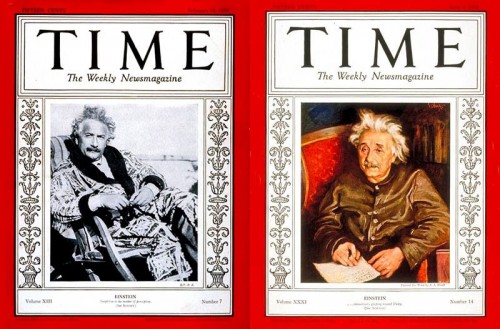
On the left is February 1929, on the right is April 1938.
In both of these, Einstein — even then the world’s most famous physicist — is basically sitting around in what looks like his pajamas. He might be thinking deep thoughts, but they’re tagged as deeply irrelevant thoughts.
(One interesting discovery: the ESVA has a copy of the photograph that the painting from 1938 is based on. In the high-res version, you can see that he’s not wearing silk pajamas, as the cover somewhat implies. He’s actually wearing a strange leather outfit. Somewhat unexpected. My wife says, “It’s like a leather Mao jacket.”)
The bomb changed all of this. Theoretical physicists became perceived as unbearably relevant — even deadly. Both Oppenheimer and Bethe started cropping their hair more closely.
Oppenheimer’s hair would only get shorter over time during his time of government tenure — perhaps a nice visual illustration of Schweber’s thesis of his moral capitulation? Bethe’s varied quite a bit over the years, though it was never quite as voluminous as it was in his more carefree days.
As for Einstein… well, the old rebel’s hair only got more unruly over time. But after the bomb, at least, they did get him to occasionally put on a suit — if only for another cover of Time.
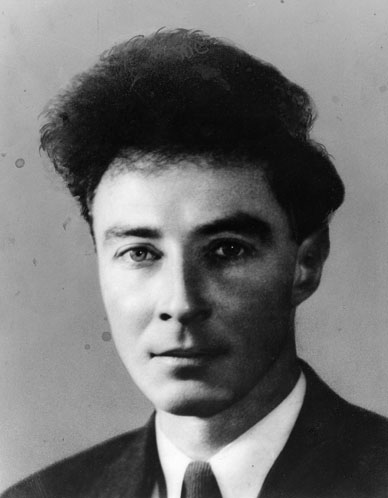
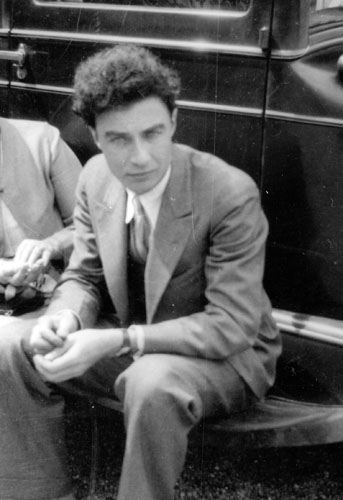
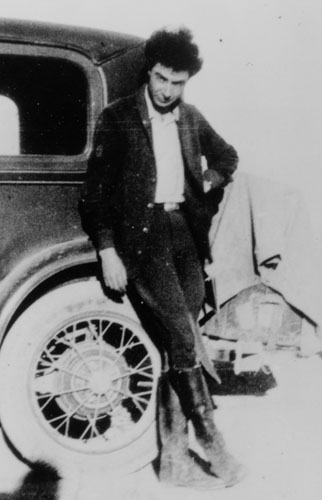
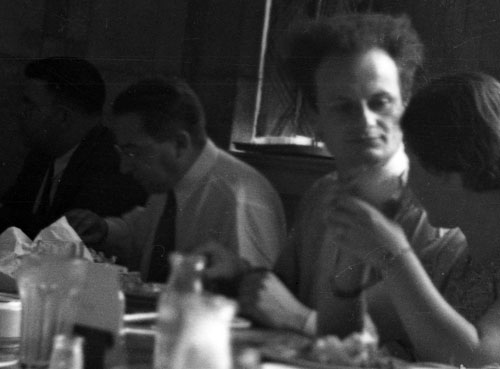
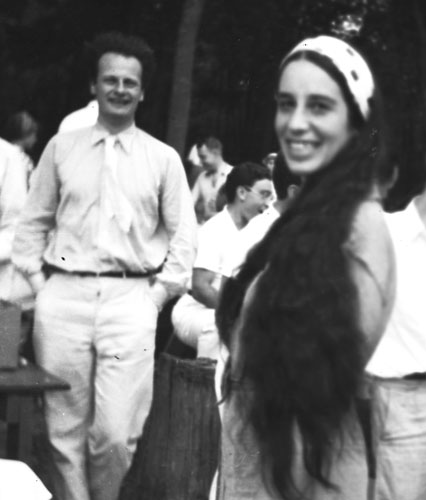




An astute and educated reader (who prefers to be anonymous) points out that this sort of unruly hair amongst young men did have a particular symbolism in late-19th and early-20th century Jewish life. From an article in Forward:
Would that apply to Oppenheimer? He seems to have picked up his crazy hair while touring Europe. Bethe was raised Christian, but his mother was Jewish. Anyway, it’s an interesting thing to keep in mind, especially when Einstein is added to the equation. Not one of those three were religiously very Jewish, but whether that reinforces or discounts the relevance, I’m unsure.
Alex,
The pic of Oppie leaning against the car is positively Dylanesque — and does suggest another tshuprinic [?] connection.
🙂
Fascinating that you sum up Oppie’s goal as “amassing a huge tactical weapons stockpile” as that is very much a counterpoint to LeMay’s “amassing a huge strategic weapons stockpile.” My dissertation argues that this conflict arose in part out of the fact that Oppie’s hunch that fallout would be a problem with thermonuclear weapons, one of his several objections to that course of action, led him to throw his weight behind tactical weapons as a means to limit fallout, among several reasons he favored low yield weapons.
Speaking of hair, LeMay had quite the mane for a general.
In the end, fallout proved to be a problem for both, as the typical employment of tactical weapons would see them fired in close contact with the surface, leading to relatively high fallout production despite the relatively smaller generation of fallout from the weapon itself versus thermonuclear designs. Of course, it took a few years for this realization that neither use of nuclear weapons was really practical except as a last resort to sink in and wasn’t sealed until the long-promised “clean” designs proved impractical at HARDTACK in 1958.
In the meantime this conflict between strategic and tactical stockpile priorities was among the reasons the Air Force put its money on Oppie’s inquisition; in either case, both were wrongheaded ideas. Fallout turned out to impose clear limits on the utility of nuclear weapons, leading to the current reality where the primary justification for nuclear weapons is deterrence, not warfighting itself, which we now realize would most likely be brief and apocalyptic.
And lead to a lot of bad hair days…
“Mr. President, I’m not saying we wouldn’t get our hair mussed…”
[…] a bonus sixth link, Alex Wellerstein at “Restricted Data” takes a hard-hitting look at “The Hair of Physicists.” (Via Alice […]
I’m going to be a total pedant and point out that, as far as I know, nobody talked about “muons” in the ’30s. Generally speaking, it was all “mesons” (if you were talking about the theoretical Yukawa particle) or “mesotrons” (if you were talking about the medium-mass cosmic ray). Actually, Bethe was the one who advocated that terminological distinction. It was only once the pi-meson, or pion, was distinguished in 1947 that the original mesotron starting being referred to as the mu-meson.
Fair enough, Will! I was thinking of mesons (something Oppenheimer spent a lot of time working on), but my brain reached to the wrong word and I didn’t think to double-check it.
These photos of Oppie are great! I suspect that Einstein, who was the only scientist of his day with any significant public exposure, started the hair thing, It was taken to the next level by director Fritz Lang, however, who created the wild-haired mad scientist in his widely seen and highly influential science-fiction film “Metropolis”. Check out the evil Dr. Rotwang’s hair in these images. The film character became the template for all mad scientists to come.
Against this background, perhaps big hair could only be carried off by scientists who really had the goods–beyond Oppie and Bethe, Feynman comes to mind. Anyone else risked being marginalized as a mad scientist.
Gotta be careful when playing into mad scientist stereotypes with your hair style – especially when working on bombs.
This brings to mind another name for this phenomenon — van de Graaff hair.
If you look like you have it, even when not touching the generator, then you really must have something going on up stairs. Yikes!
At least through his Nobel award ceremony, Dick Feynman was quite conservatively cropped. I know personally; I stood in line next to him for the same men’s room. I don’t know when he started to wear it long.
pz
[…] from 1954, after SUNSHINE had been completed. It’s a request from December 1954 from the well-coifed Hans Bethe to the aforementioned Willard F. Libby, the physical chemist best known as the […]
[…] Another from the Chicago Tribune, this one more explicitly ambivalent about what the bomb means for the future. Gotta love the depiction of the long-haired scientist… […]
[…] Staying in the 20th century we have Paul on Philadelphia’s somewhat bizarre Einstein Museum, the NYT on a strange case of biological fraud, the Smithsonian on Louis Leakey, Amy on the first women in space, Larry Moran on Stephen J Gould, Berfois on Hugh Everett, the BBC on Peter Higgs, Egil on religion and scientific change between the wars, and finally Nuclear Secrecy on the Hair of Physics! […]
[…] horrible maps or bizarre security videos or the emblems of the atomic institutions or even just one another’s hairstyles. A hauntingly grim painting that I’d love to know more about: “Atomic Landscape […]